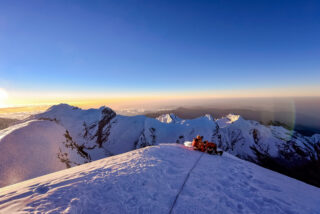
Enduring Nepal

Enduring Nepal
Our LHO Mera Peak Expedition uniquely includes the option to ski down from the summit of this incredible mountain, enhancing the adventure and broadening the experience in this remarkable region. Our expert LHO Team Leaders work in close collaboration with our certified local guides to ensure that our safety standards are always met, your skills are honed, and our legendary LHO vibe is maintained throughout this epic mountaineering journey.

TRIP TYPE
Climbing and Mountaineering

DURATION
21 Days

DESTINATION
Nepal
1
Curated with weather contingency days and includes the option to ski down from a 6,476m peak.
2
Led by our expert Team Leaders, who have years of high-altitude experience, in collaboration with selected and certified local mountaineering guides.
3
A 100% safety record on all our Himalayan expeditions.






DATE & STATUS
PRICE
TEAM LEADER
AVAILABILITY
WHAT'S INCLUDED IN THIS TRIP
WHAT'S NOT INCLUDED IN THIS TRIP
DAY 1: WELCOME TO WILD KATHMANDU
Kathmandu is an incredible, vibrant, and wild city that we’ve fallen in love with. That’s why we’re always so excited to receive you on the first day and share the gateway to the Himalayas with you.
On arrival day, you’ll be met by an LHO representative at the airport and driven to our centrally located hotel by private transfer. Navigating Kathmandu airport can be an adventure in and of itself, so you’ll receive a text with detailed instructions on how to efficiently make your way to us.
Your LHO Team Leader will be waiting to receive you at our hotel, check you in, and make sure that you have everything you need for our adventure. If you arrive early, there are loads of incredible places to visit around us. Your LHO Team Leader will send you a detailed list of restaurants, coffee shops, heritage sites, and markets to visit closer to your trip start date so that you can make the most of your time.
Our first official event of the trip is a team dinner at 7:30 pm hosted by your LHO Team Leader and local lead guide. This will be your first opportunity to meet everyone, ask any questions you have, hear all about the amazing week ahead of us, and enjoy a great meal. Although it’s difficult not to be tempted by the nearby nightlife, we recommend an early rest to recover from your travels.
DAY 2: EXPLORING THE GATEWAY TO THE HIMALAYAS
Our first full day together gives us an opportunity to discover the magical city of Kathmandu, check our gear, and get to know each other before we head out to the trail. We’ll visit the nearby sites of Durbar Square and the Monkey Temple as well as get our first taste of Nepali cuisine during our team lunch.
Due to air traffic in Kathmandu airport, the government sometimes takes the decision to assign all flights to the Everest region from an alternative airport three hours away from the city. We’ve determined that waking up exceptionally early on the day of the flight to make the land journey limits the much-needed rest before heading out on our adventure. That’s why, if flights won’t be departing from Kathmandu Airport, we will make our way to a hotel closer to our departure airport today. This gives us a chance to have a full night’s rest. Your Team Leader will inform you about the plans of the day upon your arrival in Kathmandu as this information can change regularly. Regardless, our team dinner will be at the accommodation we sleep at on the night.
DAY 3: TASHI DELEK
Distance: 9.9 KM | Ascent: 800 M | Descent: 875 M | Max Altitude: 2,820 M
Our day starts after breakfast as we make our way to the airport to board one of the most incredible flights you’ll ever take. As with all internal flights, delays are expected. Flights to Lukla are particularly notorious for never departing on time. Not to worry, though; every moment spent waiting is worth it when we get there. The flight itself takes about fifty minutes.
Once in Lukla, we’ll be met by our porter team who will collect our duffle bags and take them to a local tea house where we’ll have lunch and prepare ourselves for the trek to Puyan. Lukla is one of the most vibrant villages in the Khumbu region. It’s an important hub of local and regional commerce as well as the border to the sacred high-altitude regions. Above Lukla, animal slaughter is religiously banned. That’s why we don’t recommend choosing any meat or chicken options above Lukla.
The trek to Puyan begins on the south side of Lukla. We’ll depart in the direction of the airport and then continue past the runway of Tenzing-Hillary airport before exiting the town onto a forested trail in the eastbound direction. The trail begins with a descent to the small town of Surke nestled between two streams that make their way down into the valley. From here we begin following a series of gradual climbs along the side of the mountain broken up from time to time as we traverse corridors along the mountainside known as couloirs. The couloirs provide brief descending relief throughout our trek. The ascent of the day is moderate in nature and gradual as we approach the town of Chheubas. The towns on this side of Lukla are very small and offer a glimpse into the remote region we are soon to find ourselves in.
From Chheubas, it is possible to see Punya, our final stop for the day. The trail there is mostly flat with small descending sections. The small town of Punya consists of little more than a couple of tea houses. Upon arriving at the Tea House, your LHO Team Leader will explain a few details about how things work in tea houses generally. It will all become second nature soon enough. Dinner will be at our tea house where we’ll receive a detailed briefing about the next day’s trail.
DAY 4: FORESTS, FIELDS AND VISTAS
Distance: 10 KM | Ascent: 936 M | Descent: 816 M | Max Altitude: 2,860 M
Our second day on the trail is our first full day of trekking. Your LHO Team Leader will brief you in detail about the most efficient practices to get our day started on the right foot. It is important to always pack our duffle bags before heading to breakfast so that our porters can get a head start on their day. If we delay their departure, it may result in the late arrival of your duffle bag at our destination. Not to worry. The breakfast routine will soon feel natural, and your LHO Team Leader will be there to help you at every opportunity.
After breakfast, we’ll head out on the trail and continue along an eastbound trail in the direction of the Khari La Pass at 2,860 meters. The trail to the pass is a gradual but sustained ascent that has few brief flats. Your LHO Team Leader will use this as an opportunity to set a steady pace that will enable us to limit our unscheduled breaks while at the same time maintaining high levels of energy. Remember that our long expedition is a marathon and not a sprint.
Once at the pass, it may be possible to see our destination at Pangum. Although it may feel close, the trail is deceiving as it descends well below Pangum before ascending once again to reach the town. The descending trail is quite easy to navigate and passes through a series of small forests that increase in density as we descend further into the valley. The areas of thinning forests offer opportunities to see the incredible white peaks above. We’ll stop at a tea house on the trail for a hot lunch. We usually follow it up with some rest to digest. There is no rush here. Once we’re all set, we’ll head back onto the trail for the final sustained ascent to our Tea House in Pangum which sits on the top of a plateau overlooking the forest and the Khari-La pass.
DAY 5: NEPALI FLAT
Distance: 6.1 KM | Ascent: 709 | Descent: 624 M | Max altitude: 3,010 M
After breakfast, we’ll jump-start our day with a direct ascent to the Pangum La Pass (3,010m). This will be our first ascent above the 3,000-meter mark. Although this isn’t usually a major threshold, when combined with our long-term trajectory for this expedition, this is a noteworthy milestone. The trail begins inside the dense forest as it briefly climbs to the pass. From here, we’ll begin our crossing of the fabled, awesome, and empty Inkhu Valley. The trail reaches a junction with a series of small tea houses lining either side of the trail. This tiny village is called Bhusme and is significant to us because it is the last permanently habitable village on our adventure. This is where we’ll stop for lunch and a rest.
Continuing straight along the path leads to the foothill trails linking Lukla to the villages of the Soulu region. The perpendicular trail turning left heads deeper into the high mountains of the Khumbu region. That’s our route! From the junction, we will be heading directly towards Ningsow, where the trail is characterized by what we call “Nepali flat.” That means there are some small inclines and drops but that it largely stays within a similar altitude range.
Our approach to Ningsow offers some opportunities to see the towering glacier peaks at the end of the valley. With a spot of luck, it may be possible to see Mera Peak just peering over the hills at the very end of the valley. Our arrival in Ningsow marks a milestone on our expedition because it is the first time we’ll be sleeping at a campsite rather than a tea house. Upon arriving at the campsite, it’s best to go into your tent and prepare it for the night before heading to the mess tent or doing anything else. Your LHO Team Leader will brief you in detail about how we check in to our campsite and what are the most efficient practices to make it as smooth as possible. Dinner will be prepared by our expedition chef and served in our mess tent where we’ll receive a detailed briefing for the next day of our epic adventure.
DAY 6: ENTERING THE INKHU KHOLA VALLEY
Distance: 7.3 KM | Ascent: 1,321 M | Descent: 809 M | Max Altitude: 4,150 M
Checking out from our campsite may feel a little bit overwhelming the first time, but your LHO Team Leader will help provide you with a methodical way to go about it that is easy to follow. It’s always best to pack up your duffle bags first and make sure that all personal equipment is ready to go so that our porters can get a head start. Once we exit the tents to have breakfast, it’s best to be ready to leave from the mess tent without needing to return to our tents after breakfast. This keeps our momentum moving in one direction and also enables our supporting staff to begin their work packing everything up and heading out to create the same set up for us at our next destination. This will all become second nature soon enough.
After breakfast, we will continue our northbound trajectory deeper into the valley. The trail begins with an ascent through the thick pine forest. It is possible to spot Rhododendrons on this section of the trail, providing a splash of color to the green surroundings. The trail is a sustained ascent that breaks out of the forest to an open hillside offering views of the towering peaks above. Continuing along the valley, the trail descends to cross the Inkhu Khola. After crossing the river, we’ll ascend to the small settlement of Pangkongma, where we’ll have lunch.
The afternoon is largely spent ascending towards Chhetra Thanga. The trail climbs through dense forest and steep terrain, making it a challenging yet rewarding journey. The scenery around us changes rapidly as we ascend, and we’ll witness the transition from lush greenery to alpine landscapes. Chhetra Thanga is a picturesque campsite situated at the confluence of two rivers, surrounded by beautiful mountain views. Our team will set up the campsite, and you can relax and enjoy the stunning natural surroundings. Dinner will be served in the mess tent, and your LHO Team Leader will provide a detailed briefing for the next day’s trek.
DAY 7: KOTHE ON THE RIVER
Distance: 6.1 KM | Ascent: 905 M | Descent: 508 M | Max Altitude: 3,600 M
Now that we’ve completed a full cycle of checking in and checking out of our campsite, the mornings will start to feel fairly routine. After breakfast, we’ll begin our walk deeper into the Inkukhola valley towards Kothe. This day is comparatively shorter than the previous two days on the trail. It consists of a short ascent initially followed by a gradual descending trajectory over “Nepali flat” terrain.
The trail starts with an ascent along the mountainside before connecting with a small ridge that climbs above our campsite in the north-westerly direction. From there, we begin following the top of the thinning tree line as the valley floor beneath visibly starts to ascend and meet our trail. Kothe is visible almost immediately from the top of the ridge. As we begin descending towards it, our trail merges with the high pass trail coming down from the Thuli pass before we find ourselves walking directly next to the Hinku Drangka River.
From there, it’s a short walk to Kothe where we’ll have lunch and spend a lazy afternoon resting and enjoying our natural environment before dinner. At Khote, we’ll be staying in tea houses rather than a campsite. However, as this is not a permanent settlement, we may need to use camping equipment and tents during certain times of the season when the tea houses are closed. Your LHO Team Leader and local lead guide will let you know where we’ll be staying on this night closer to the time. We’ll hear a detailed briefing for the following day during our dinner.
DAY 8: GLACIER LAKES AND SUMMIT VIEWS
Distance: 10.1 KM | Ascent: 891 M | Descent: 20 M | Max Altitude: 4,700 M
From here onwards, our trail is characterized by the towering glaciers and high summits of the high Himalayas as we leave the forests and streams behind us and enter the high-altitude environment. After breakfast, we’ll depart in the northbound direction deeper into the Inkukhola valley.
The wide rolling hills are now replaced with towering sharp cliffs on either side of us as the trail follows the river deeper and deeper into this incredible place. The trail is long and gradual throughout the entire day. Peak 43 claims its place at the head of the valley in the direction of our walk, with Mera Peak adjacent to it on the right.
During the early section of the ascending trail, it is possible to see Mera Peak above us on our right-hand side. Because the trail is mostly “Nepali flat,” it is easy to pick up our pace and move quite rapidly. Your LHO Team Leader will go to great lengths to try to slow us down and set a steady and sustainable pace that enables us to properly acclimatize and limit our unnecessary exposure to the symptoms of high altitude.
At the midway section of the valley, we’ll stop for a picnic lunch and some rest. The trail from the picnic begins to ascend towards a glacier moraine that forms at the base of Peak 43 and Mera Peak. A moraine is where the glacier used to be and is subsequently formed by the recession of the glacier. We will ascend along the moraine to our campsite at Thangnak. The beauty of this place cannot be overstated. We’ll be flanked by the Sabai Tsho glacier lake, we’ll be at a junction of three glaciers, and we’ll be beneath the 6000-meter summits of Kusum, Kyashar, and Mera Peak!
After checking in, it is possible to take a short walk up to the glacier lake viewpoint. Dinner will be in our mess tent where we’ll hear the briefing for our next day in this incredible region.
DAY 9: ACCLIMATIZATION & CHILL
Finally, a rest day! Sort of. The good news is that we won’t need to pack up our stuff today. We can leave our tents exactly as they are. After breakfast, we’ll get a late start with the aim of breaching 4500 meters of altitude for the first time during this expedition.
The reason why we go high and then come back is to encourage our bodies to start producing the red blood cells needed for the higher altitude while at the same time enabling ourselves to recover quicker by sleeping at a lower altitude. Although it is desirable to try and reach a higher altitude, it is equally desirable to try to enable rest and recovery.
That is why your LHO Team Leader and local lead guide will make a determination as to how far we’ll be walking. In some instances, where energy is generally low and weather conditions are not conducive, we may choose to spend the day at the campsite.
Regardless of our decision, both lunch and dinner will be at our campsite. Your LHO Team Leader will let you know what decisions have been taken regarding this day closer to the time.
DAY 10: THE GATEWAY TO THE GLACIERS
Distance: 4.5 KM | Ascent: 633 M | Descent: 10 M | Max Altitude: 5,045 M
Our last day of trekking on the dry trail starts after breakfast. We’ll once again pack everything up and head out in the north-easterly direction along the glacier moraine. The summit of Mera Peak will be clearly visible to our right-hand side as we circle around the northwest face in the direction of Khare.
The trail is mostly gradual and goes along several interconnected moraines before climbing slowly towards the terminal moraine of both the Hinku Shar and Mera La glaciers. Khare is home to several tea houses that we use when they’re open. The tea houses in this region are less frequented than those on the Everest trail. That’s why they are unpredictable in terms of when they might be open.
If they are open, we’ll be arriving in time for lunch and will be having both lunch and dinner at the tea house. If they’re closed, then our LHO team will set up a campsite for us to use, as we’ve done on previous nights. Arriving at Khare marks the next major milestone of our expedition. This is the last stop before we finally get onto the glacier. Your LHO Team Leader will provide you with a detailed briefing about the happenings both in Khare and for the next day. The views are beyond stunning from Khare, making every moment on the trail well worth it.
DAY 11: GLACIER TRAINING ON MERA LA
Distance: 5.3 KM | Ascent: 552 M | Descent: 552 M | Max Altitude: 5,300 M
We’ll be spending a second night in Khare. That means we won’t need to pack up our stuff today. After breakfast, we’ll head out in the direction of the Mera La glacier. This day is significant for two main reasons. Firstly, we’ll be breaching the 5000-meter altitude threshold which is in and of itself a major achievement. We will also have our first training opportunity on the glacier with the use of technical mountaineering gear.
Your LHO Team Leader and local lead guide will brief you on the specifics of what to pack for this day, but you will need your ice axe, crampons, mountaineering boots, harness, and helmet. The ascent to the glacier from Khare follows a westbound trail that begins by traversing dry soil before. This section isn’t steep, but at these altitudes, even gradual trails can feel somewhat demanding.
The dry soil slowly begins to give way to small rocks known as scree. This typically forms where there are receding glaciers in high altitude. It is important to be sure-footed on this section as the void to our right side can be quite steep. The traverse along the scree follows a series of short ascents and descents before finally reaching the glacial ice.
Your local lead guide will determine where the entry point to the glacier will be before we make our way there. We will take our time here to put on our technical gear and gain a full briefing on what tools we’ll be using on the ice. This briefing will be supplementary to the briefing we would have heard at our dinner table the previous night, so we won’t be hearing all this information for the very first time here.
Once we’re all geared up, we’ll begin our training. The focus will be on the use of proper crampon techniques and the proper use of an ice axe on gradual glaciated terrain. We’ll also be setting up some fixed ropes to learn how to use a jumar and how to abseil on the ropes as well.
We won’t be doing everything all at once and will have at least two more opportunities to practice before we put it to actual use on our summit bid. We’ll have a picnic lunch on the glacier before we descend back to Khare for some well-deserved rest. Your LHO Team Leader will brief you fully about the epic experience ahead of us for the following day before we turn in for the night.
DAY 12: MERA PEAK BASE CAMP
Distance: 2.7 KM | Ascent: 566 M | Descent: 0 M | Max Altitude: 5,300 M
Mera Peak base camp will be a familiar sight to us when we arrive. It sits only a few hundred meters beyond where we had been training on the previous day. Although most expeditions start late today since it is a short journey, we choose to depart early and take advantage of a full day on the glacier to practice our skills and fill in the gaps from our previous skills-focused day.
We’ll be packing everything up today for our final departure from Khare and retracing our steps back up to the Mera La glacier following the same path. Once at the glacier access point, we will once again put on our technical gear and begin ascending the glacier. This time, we’ll pass our training spot and continue onto the wide portion of the glacier heading now in a southbound direction. The Mera Peak summit will be visible directly in front of us as we approach base camp. The glacier here is wide and gradual. Our most concerning objective challenge is crevasse. These are air pockets in the glacier that can be concealed from view. That’s why we’ll be roped up throughout our ascent to base camp.
Once there, we’ll check in, have lunch, and rest. In the early afternoon, we’ll head out for some more training on the glacier. This time we’ll focus on more advanced crampon techniques, how to keep our weight on our feet rather than on our arms when using the fixed lines, and also on efficient descending techniques which are often overlooked but are even more important.
Our training will also be used as a mini-acclimatization opportunity since we’ll be ascending past the base camp close to 5,500 meters before returning to base camp at 5300 meters for rest and recovery. Dinner will be at our nearby campsite where we’ll receive our full briefing for the next day.
DAY 13: HIGHER ON THE MOUNTAIN
Distance: 1.9 KM | Ascent: 347 M | Descent: 83 M | Max Altitude: 5,800 M
Our second day on the glacier is about reaching the high camp further up along the Mera La glacier. After breakfast, we’ll depart base camp in a southbound direction. The summit will be straight in front of us throughout the day. The trail is gradual but sustained as we ascend past the many crevasses that litter this section of the glacier. We’ll be employing some of the skills used during our training to climb safely into higher altitudes. Ski mountaineers will be able to skin up on their skis for this section as conditions are usually good.
As this is a short day, we will be using our ascent as an opportunity to further build our skills. The specific trail that we choose will have obstacles that are avoidable but that we want to use to build on the two prior days of training. If the weather doesn’t permit, we’ll save some of these training opportunities for when we arrive at high camp.
The camp sits on a small rocky spur to the east side of the glacier. The spur is above a snow ridge that opens up views towards the eastern slopes of the mountain as well. Immediately behind us is the Everest region with summits with the possibility to see Ama Dablam, Taboche, Makalu, Lhotse, Nuptse, and Everest itself. Once we arrive at the camp, we’ll check in, have lunch, and get some rest. Training opportunities will take place up to lunchtime. After that, the aim of the afternoon and evening is to rest. Your LHO Team Leader and local lead guide will let you know what time to be up for dinner where a full summit briefing will take place. We highly recommend sleeping shortly after dinner. Even if the excitement keeps us up, it is important to allow our bodies this time to recover and ready itself for the highlight of our adventure together.
DAY 14: SUMMIT SUMMIT SUMMIT (6,461m)
Distance: 8.5 KM | Ascent: 605 M | Descent: 1,504 M | Max altitude: 6,461 M
The departure from high camp will be in the typical pre-dawn hours of major summit attempts, usually between midnight and 3 AM. Your LHO Team Leader and local lead guide will provide details on the wake-up call and breakfast time during our briefing the night before. We’ll have a light breakfast before leaving the camp. It’s recommended to store sugary snacks in accessible pockets for quick access, minimizing breaks to avoid getting too cold. The colder we get, the harder it is to resume and the more energy we lose. To compensate for fewer breaks, we’ll maintain a slow and steady pace manageable for the entire team.
The trail from high camp continues with a gradual incline along the Mera La glacier, following the same trajectory as the previous two days. The glacier leads southbound, connecting to a shoulder above the icefall of the summit ridge. Mera Peak becomes visible on our right as we approach and navigate onto the icefall. On the shoulder, watch out for large crevasses, concealed by snow. Turning right in a westerly direction, we face the final sharp ascent to the summit dome. Mera Peak, like a dome surrounded by glaciers, requires the use of fixed ropes and abseiling for a safe ascent and descent. Climbing the dome one by one, we reach the summit, offering spectacular panoramas, including Shishpingma, Choy Oyu, Lhotse, Everest, Makalu, and Kachunjaga – six of the world’s 14 peaks above 8000 meters. Time at the top depends on conditions and energy levels. After photos, we’ll abseil down the dome to reach the glacier. Skiers fix their bindings for the descent, while others retrace steps to the shoulder and then back onto Mera La glacier. Once back at high camp, we’ll pause to grab food, pack up, and begin descending directly to Khare, where a well-deserved dinner awaits. Skiers will also stop at high camp to pack up and then continue on skis until the snow line. We’ll regroup in Khare for a team dinner.
DAY 15: CONTINGENCY DAY
Extra days are built into the program for adverse weather conditions, extra acclimatization, or training on the way up. Unused contingency days at the end cannot be used as extra nights in Kathmandu.
DAY 16: CONTINGENCY DAY
Extra days are built into the program for adverse weather conditions, extra acclimatization, or training on the way up. Unused contingency days at the end cannot be used as extra nights in Kathmandu.
DAY 17: LEAVING THE GLACIERS
Distance: 14.3 KM | Ascent: 37 M | Descent: 1,504
After breakfast, we’ll descend along the same trail used for the ascent. Beginning along the glacial moraine, we’ll then veer towards Sabai Tsho Lake. Passing our previous week’s campsite, we rejoin the Hinku Drangka River carving through the Inkukhola valley. The trail is easy and gradual, with a substantial horizontal distance to cover. A picnic lunch awaits at the start of the Inkukhola valley before continuing riverside to reach Khare, our home for the evening. Tea houses in Khare may not always be open due to its remoteness and lack of popularity, so we’ll either stay at a tea house or have our tents set up. Dinner at the campsite includes a detailed briefing for the second leg of our descent.
DAY 18: IT AIN'T OVER YET!
Distance: 6.8 KM | Ascent: 1086 M | Descent: 429 M
Our last full day on the trail is a significant achievement, having conquered over 6400 vertical meters. Taking a shortcut over the Thulikharka pass to approach Lukla, we avoid an additional night on the mountain. Departing Khare, we follow the same trail as the ascent, characterized by “Nepali flat.” Continuing until the trail gains distance from the river, we reach the junction of the ascending trail towards the pass and the continuous trail towards Ningsow. Lunch and a short rest precede our climb up to the pass, with demanding switchbacks ascending directly to above 4000 meters. The thin forest gives way to short grass vegetation and finally to a dry environment, similar to what we experienced in Khare the day before. The south face of Mera Peak dominates the skyline. Our final stop is high up near the pass, where the Thulikharka lodge sits alone in the middle of an epic expanse of Himalayan vistas. Like previous tea houses, we’ll either stay there if open or set up a camp, with the LHO Team Leader providing information closer to the time. Dinner includes our last full briefing.
DAY 19: LUKLA BY THE ZATRWA LA PASS (4,540m)
Distane: 10.1 KM | Ascent: 489 M | Descent: 1867 M
Our final day together is no leisurely stroll. After breakfast, we’ll ascend to Zatrwa La Pass at an altitude of 4,540 meters, marking the last high point of our journey. The ascent covers about 300 meters to the pass, navigating a mix of rocky trails, scree areas, and a few small switchbacks. From the pass’s summit, a familiar sight unfolds – Lukla and the runway of the Tenzing-Hillary airport.
We commence our descent directly from the pass, following a scree trail along the mountainside that gradually merges with a dry trail amid short grass vegetation. As we lose altitude, the landscape transforms with the appearance of trees, followed by denser forests. We’ll pause for lunch at a tea house along the trail.
The trail introduces us to small villages, a contrast to the experiences of the past few weeks. Here, the hustle and bustle of commercial life come to life, with traders and donkey caravans animating the trails. After lunch, we continue our descent into the town of Lukla. Checking into our tea house, we’ll indulge in a well-deserved shower and explore the vibrant Sherpa town’s cafes and pubs. Dinner at the tea house will include information about our flight schedule back to Kathmandu for the following day.
DAY 20: KATHMANDU DOESN'T CHANGE
Hot showers await us on our return to Kathmandu! We’ll be catching our flight out early in the morning; however, this depends entirely on the weather situation. Patience is key when it comes to aviation in Nepal, although we’ll do our best to make it as smooth as possible. Depending on when we move, lunch will either be in Lukla, Kathmandu, or the alternative airport sometimes used to direct Lukla air traffic that is inbound to Kathmandu. Wherever we finally land, we’ll do our best to get you to the hotel as soon as possible so that you can shower, rest, and enjoy Kathmandu before our farewell dinner.
DAY 21: NAMASTE!
The last day together is dedicated to airport transfer and farewells. Breakfast is included on the day. Please make sure to provide us with the correct departure details when filling out your Team Details Form before the first day of the trip so that arrangements can be made. We’ll be arranging your shuttle 3 hours before departure, so please make sure to be near the hotel at the time so as not to be late. For those of us departing late, we’re happy to recommend places to visit or arrange for a city tour if you weren’t able to attend it on the first day. Please communicate any changes to your flight with your LHO Team Leader as soon as possible so that arrangements can be made.

OUR COMMITMENT
We are dedicated to ensuring that everyone involved in our services receives a fair living wage in their respective countries. We invest in our team members, fostering upward mobility within the adventure travel industry, expanding educational opportunities, and offering support wherever we can. By joining an LHO adventure you are directly impacting the incredible people and the remote communities that make these life-changing experiences possible.
LEARN MORE
HEALTH & SAFETY GUIDELINES
We do our best to ensure your wellbeing on LHO adventures. That's why the facilities we use throughout our trips are required to meet our health and safety standards. We also follow the laws and protocols of every country that hosts our adventures. This extends to national regulations requiring Covid-19 testing, vaccination certificates, mask wearing or any other local guidelines that may apply. Contact us for the most up to date protocols related to your destination.
LEARN MOREWhat's the accommodation like on the trip?
For the nights spent in Kathmandu, we use carefully selected accommodation that blends international standards and local tradition. You can expect a good level of general comfort including private toilets, comfortable beds, garden areas, easy access to main markets and walking areas, front desk, concierge, restaurant and breakfast area. On the Mera Peak trail, we stay in a combination of tea houses and camping accommodation. Tea Houses are basic family-run accommodations that are very much pa
For the nights spent in Kathmandu, we use carefully selected accommodation that blends international standards and local tradition. You can expect a good level of general comfort including private toilets, comfortable beds, garden areas, easy access to main markets and walking areas, front desk, concierge, restaurant and breakfast area. On the Mera Peak trail, we stay in a combination of tea houses and camping accommodation. Tea Houses are basic family-run accommodations that are very much part of the experience when trekking in the Himalayas. They consist of shared bathrooms, showers, and a restaurant. We do not sleep in tents at any point on this adventure. At Mera Peak Base Camp and the forward camps along the mountaineering portion of this expedition, we will be staying in technical tents.
Do you recommend camel back bladders for water?
For the trekking portion, camel backs, also known as water bladders, are recommended for this trek. Basically, it's a sack of water that's put into the backpack and comes with a straw that can be clipped to the shoulder strap for easy access to water without having to pull the bottle out of the backpack to drink. For the mountaineering portion of this expedition, we recommend only using reusable water bottles and leaving the bladder at base camp. Please be sure to have enough capacity for 3 l
For the trekking portion, camel backs, also known as water bladders, are recommended for this trek. Basically, it's a sack of water that's put into the backpack and comes with a straw that can be clipped to the shoulder strap for easy access to water without having to pull the bottle out of the backpack to drink. For the mountaineering portion of this expedition, we recommend only using reusable water bottles and leaving the bladder at base camp. Please be sure to have enough capacity for 3 liters.
How can I charge my devices and power banks? Do tea houses charge for using electrical outlets?
It's possible to charge electronics at the tea houses. Just keep in mind that power outlets are usually limited and demand for them is huge. Use any charging opportunity to fill up your power banks. Most tea houses will charge a fee between 200 to 500 Rupees to fill up a power bank. At the base camp charging is not possible. Our last opportunity to charge will be at the last tea house. Consider having enough power bank capacity for three days without recharging.
It's possible to charge electronics at the tea houses. Just keep in mind that power outlets are usually limited and demand for them is huge. Use any charging opportunity to fill up your power banks. Most tea houses will charge a fee between 200 to 500 Rupees to fill up a power bank. At the base camp charging is not possible. Our last opportunity to charge will be at the last tea house. Consider having enough power bank capacity for three days without recharging.
How much should I carry as spending cash?
We recommend around 200 USD. This does not include any discretionary tip you may wish to leave. Our tipping recommendation on this experience is 350 USD.
We recommend around 200 USD. This does not include any discretionary tip you may wish to leave. Our tipping recommendation on this experience is 350 USD.
SIGN UP TO OUR NEWSLETTER
PAYMENT PLANS AVAILABLE
£4,640
SIGN UP TO OUR NEWSLETTER
INQUIRE NOW
This adventure is only available as a private trip and is customized to your requirements, experience and skill level. To get started, please fill out the form below. We’ll be in touch soon to put it together for you.
"(Required)" indicates required fields
CONTACT US
We’re passionate about guiding you to epic adventures and beyond. If you have any questions at all, don’t hesitate to reach out. We’d love to hear from you.

